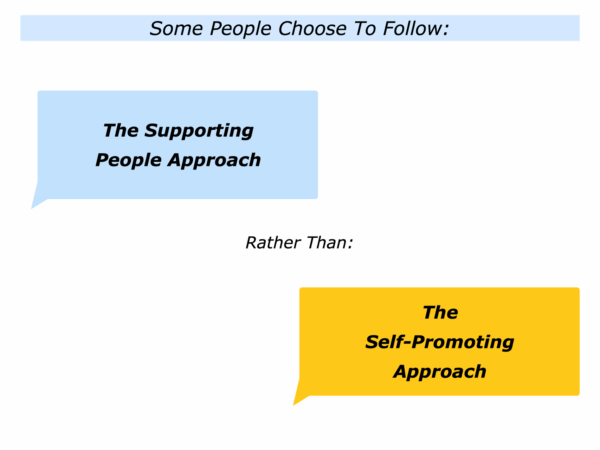
Different people choose different ways to shape their careers. The route they take can have pluses and minuses for both themselves and other people.
Some aim to follow the supporting people approach. When appropriate, they use their strengths: a) to support people; b) to clarify people’s specific goals; c) to help people to achieve success.
Such people may also aim to pass on knowledge that others can use in their own ways to shape a positive future. They like to help people to achieve success.
Some people follow the self-promoting approach. They aim to sell themselves and sometimes talk about their personal branding. They may or may not help other people to achieve success.
Different people follow these routes in different ways. Let’s explore these themes.
The Supporting
People Approach
There are many ways to follow this approach. Some people who aim to help others often demonstrate the following characteristics. They will, of course, express these in different ways.
They have a strong service ethic
Such people have a strong service ethic. They want to give to others and help them to succeed. Different people arrive at this point for different reasons.
Some learn this approach from their parents, teachers or other key people. They may have had people who encouraged and helped them in their lives or work.
Such people are grateful for being given such help and want to offer similar experiences to other people. They aim to be generous, kind and encouraging.
Some people may aim serve something greater than themselves. They may aim to serve their loved ones, a spiritual faith, a purpose, a vocation or something they believe in.
Different people choose different vehicles when taking this path. They may aim to inspire people, find a medical cure, build a better society or do something practical to encourage present or future generations.
Such people often feel alive when following this path. Some may also go into a state of flow. Their sense of self disappears but it emerges stronger later.
Some may find themselves to be fully present. They have a sense of purpose, follow their principles and work towards achieving a picture of success.
Different people do this in different ways. This can sometimes involve focusing on the next step.
They clarify their strengths
Such people want to support others and aim to do this in their lives and work. They also focus on how they can use their particular strengths to help other people. Some start by exploring the following questions.
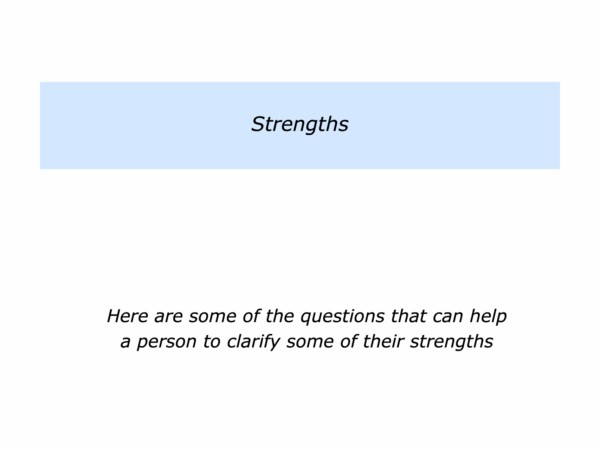
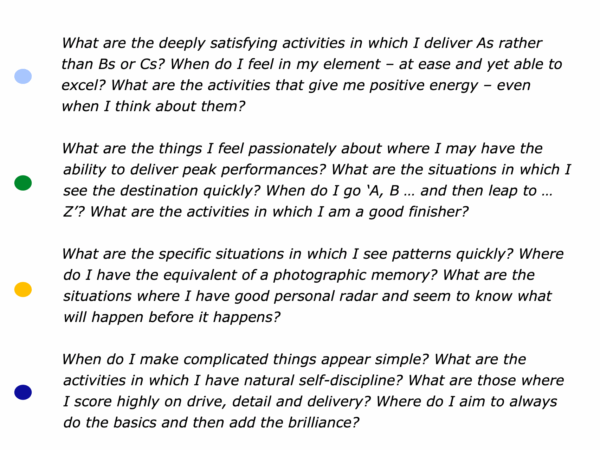
They clarify the specific
things they can offer to people
Imagine that a person has clarified some of their strengths. Bearing these in mind, they may then aim to clarify the specific things they can offer to help people.
Different people will be able to offer different things. Here are some of the topics that they may describe when clarifying their offering.
My Offering
Bearing in mind my strengths, the specific things
I can offer to help people are to help them:
To regain their health … To follow their principles … To find a new job and do satisfying work … To use their dyslexia as a strength … To manage transitions successfully … To work towards their life goals.
To use technology to simplify their lives … To lead superb teams … To build a positive culture … To manage specific challenges … To do their best in certain situations … To focus on what is really important in life.
This seems a simple approach. But it can help a person to summarise the specific things can deliver to help people, teams or organisations. They can also try to bring these to life by giving specific examples.
Much depends on their strengths, of course, and the kind of work they aim to do. They may aim work in the field of health care, coaching, hospitality, technology, business or another area. Bearing these things in mind, here is an exercise the person may wish to do.
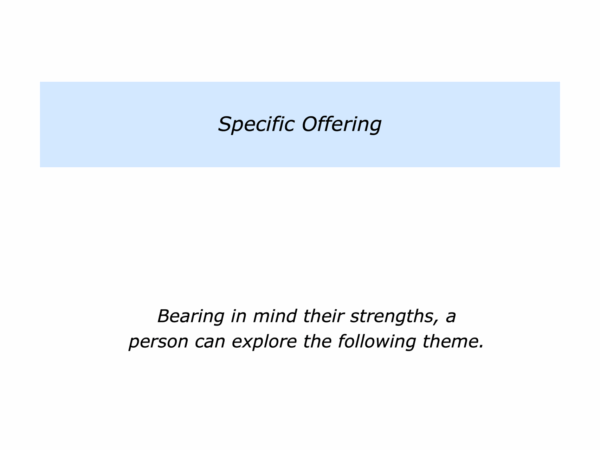
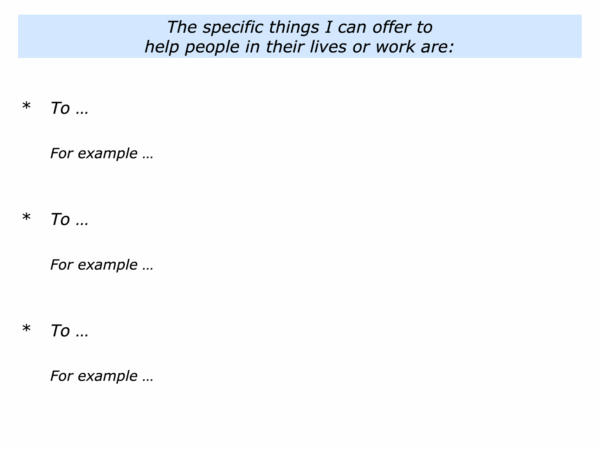
Imagine that a person has a strong service ethic. They have also clarified their strengths and what they can offer to people. When appropriate, they may take the following step.
They follow their chosen way of supporting
people and helping them to achieve success
Different people do this in different ways. Some aim: a) to clarify the kinds of people they feel most able to support; b) to clarify their chosen way of supporting these people and helping them to achieve success.
Again, much depends on a person’s strengths and what they can offer to people. Bearing these things in mind, however, some people take the following steps.
They clarify the kinds of people
who may be open to what they offer
This can be a vital step because it is important to focus on the potentially fertile ground. Whilst the person may have certain strengths and skills, some people may be more open to the specific help they offer. They may therefore explore the following questions.
Who are the kinds of people who may be open to what I offer? What are the characteristics of these people? What are the kinds of challenges they face? What may be the goals they want to achieve in their lives or work?
A person may also work best with people who want to explore certain kinds of challenges or who work in particular professions. Looking at my own work, for example, I often work best with people:
Who have a positive attitude and want to explore particular topics in their lives or work;
Who are open to focusing on positive models and practical strategies that work in specific situations;
Who are prepared to follow these ideas in their own way to achieve their personal or professional goals.
Imagine that a person has clarified the kinds of people who may be open to what they offer. They may then focus on the following theme.
They clarify how they can, when appropriate,
offer these things in a way that may
be attractive to certain kinds of people
A person who wants to support others will also follow certain principles when helping people. They may therefore take the following steps when taking this approach.
They aim to always show respect to people. They also focus on people who may be open to exploring certain topics. They will not try to impose their ideas on other people.
They will, when appropriate, communicate what they can offer in a way that may be attractive to certain people. They may do this by aiming:
To show they understand the person’s world and, for example, the challenges they may face or the goals they may want to achieve;
To, when appropriate, explore the benefits of some things they may offer – such as following certain strategies or applying certain practical tools;
To pass on knowledge in a way that can help the person – or the group of people – to work towards achieving their goals.
Such individuals will focus on helping motivated people who are open to exploring the possible ways forward. They will do this in a way that continues to respect them and helps them to achieve their personal or professional goals.
Different people share what they can offer in different ways. Much depends on the kind of approach they find comfortable following. Let’s look at some examples.
The Success Stories Approach
This involves producing success stories that may show how some of their clients have achieved success. When doing this – and with the client’s permission – it can be important:
To put the client – rather than themselves – at the centre;
To, when appropriate, describe some of the strategies and tools that the client used to tackle challenges or achieve their goals;
To build a portfolio of such stories that may resonate with other people.
This approach can help to share examples of what a person can offer and how these can be used to achieve success.
The Website Approach
This involves creating a website and, for example, a blog that people may find useful. People do not necessarily buy because of a website, but it can provide a shop window.
The first step is to clarify the purpose of the website. They may aim:
To produce success stories and pass on knowledge to people;
To provide positive models and practical tools that people can use in their own way;
To provide a flavour of what they can offer;
People who take this approach aim to share knowledge. Sometimes, as a by-product, it can also lead to getting work.
The Supporting People In
Their Network Approach
This involves a person being generous and helping people in their network to achieve their goals. People who do this often take the following approach to networking. They believe that:
Real networking is about helping other people to succeed. It is not about self-promotion.
Such people are not necessarily looking for anything in return. But there may be times in the future, however, it leads to potential possibilities.
Let’s return to the topic of a person sharing what they offer in a way that can be attractive to people. As mentioned earlier, there are many ways to take this step. One approach is for them to clarify their strategy to doing this by completing the following exercise.

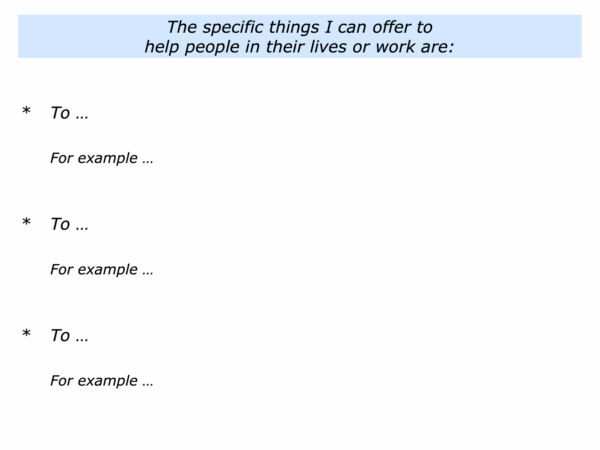

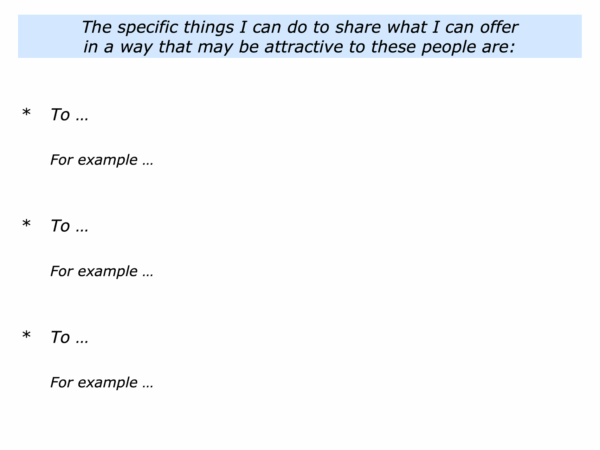
Imagine that a person has taken some of these steps. They may then focus on the following theme.
They follow their chosen way
of supporting people and
helping them to achieve success
Different people do this in different ways. Much depends on their strengths, their successful style of working and the specific situation where they may aim to support people.
Some may do this their personal life when acting as a friend, partner, parent or in another roles. They do this in a careful way that supports people, however, rather than going around trying to fix people.
Some may do this in their professional life. They may aim to do this when working as an educator, medic, counsellor, mediator, writer, artist, reporter, leader, specialist or in another professional role.
Depending on their strengths and successful style of working, different people follow different ways of sharing what they offer. They may prefer to work as an individual, a leader or another way of contributing to an organisation.
Some may do this in face-to-face situations. Some may do it through writing, making films or using other media. Some may pass on knowledge in other ways to help people to achieve success.
Such people may therefore do the following exercise. This can help them to clarify and follow their chosen way of supporting people and helping them to achieve success.
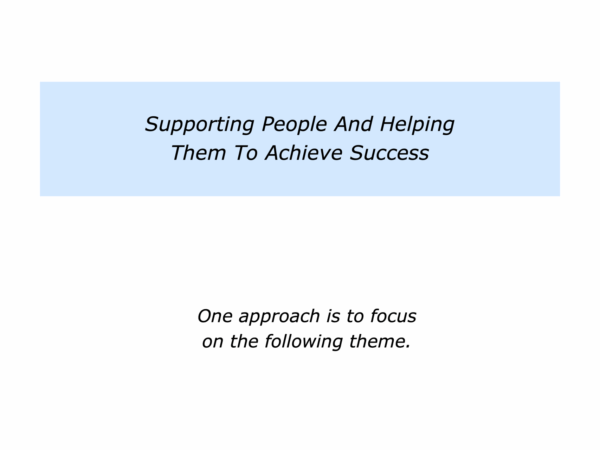
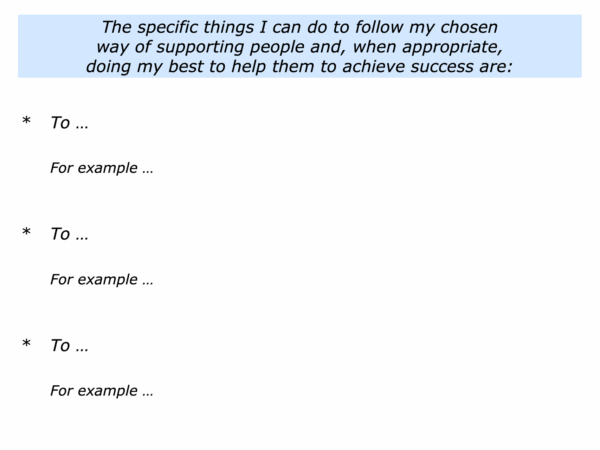
Such people often love to share knowledge. They are happy to promote the work and how it can help people. But they often don’t feel comfortable promoting themselves.
They love to give and sometimes may experience the helper’s high – but that is a by-product. The real work is about helping others and serving something greater than themselves. It is not about them.
The Supporting People Approach
Has Both Pluses And Minuses
Different people choose different ways to shape their careers. Whatever route they take, however, can have pluses and minuses for both themselves and other people.
One key point is worth underlining. People who aim to help others often need to focus on the things they can control in situations. Whilst they can do their best, some things may be beyond their control.
Such a person can continue to have a positive attitude, be professional and aim to help people. But they cannot necessarily control what people do with the things that are offered.
Let’s consider some of the pluses and minuses that individuals may encounter when supporting other people. They may then aim to build on the pluses and manage the consequences of any minuses.
The Potential Pluses May Be:
The person may be following the principle they believe in … They may be playing to their strengths … They may be able to work with people who are open to what they offer.
They may be able to make a living doing satisfying work … They may continue to develop and improve the ways they can help people … They may help people to tackle challenges and achieve their goals.
The Potential Minuses May Be:
The person may find it difficult to clarify what they offer … They may find it hard to make a living doing these things … They may find it challenging to reach the kinds of people with whom they may work best.
They may be unrealistic about their ability to help different kinds of people … They may sometimes fall into trying to persuade people … They may find that some people take advantage of their generosity.
Some people clarify these things. As mentioned earlier, they then aim to build on the pluses and manage any minuses. They then do their best to support people and help them to achieve success.
The Self-Promoting Approach
People who follow this approach make everything about them. They sometimes talk about their personal branding and aim to sell themselves to potential buyers.
Some individuals may claim to be the smartest person in the room and brag about their achievements. Some are addicted to getting attention and can never get enough praise.
Such people may focus only on their own agenda and are not interested in other people’s aims. Some say they are serving people but they are using these people as pawns in pursuit of their own goals.
The Self-Promoting Approach
Has Both Pluses And Minuses
People who take this approach produce both pluses and minuses for themselves and other people. These can include the following.
The Potential Pluses May Be:
They may feel important and superior … They may believe in their own infallibility … They may believe that they are an expert in many different subjects.
They may get a kick from voicing their extreme opinions … They may gain status and applause from some followers … They may enjoy blaming or scapegoating other people.
The Potential Minuses For
Themselves Or Other People May Be:
They may be addicted to getting attention … They may never be satisfied with the status or applause they get … They may always be driven to get more, more and more.
They may behave in ways that hurt other people … They may create lots of collateral damage … They may be constantly paranoid and worry that some people will take away what they have gained.
Different people choose to follow different paths in their careers. Some aim to support other people. Some focus on self-promotion.
Let’s return to your own life and work. Can you think of a situation where you may want to follow elements of the supporting people approach? How can you stay humble in the process?
What may be the situation where you want to help a person or a group of people? How can you show respect to them? How can you clarify the topic they want to explore?
How can you clarify their goals? How can you, when appropriate, offer practical strategies and tools that work? How can offer these in a way that may help them to achieve success?
If you wish, try tackling the exercise on this theme. This invites you to complete the following sentences.
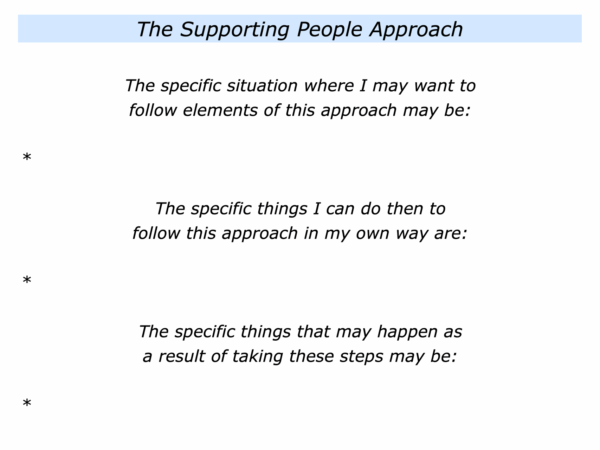


Leave a Reply